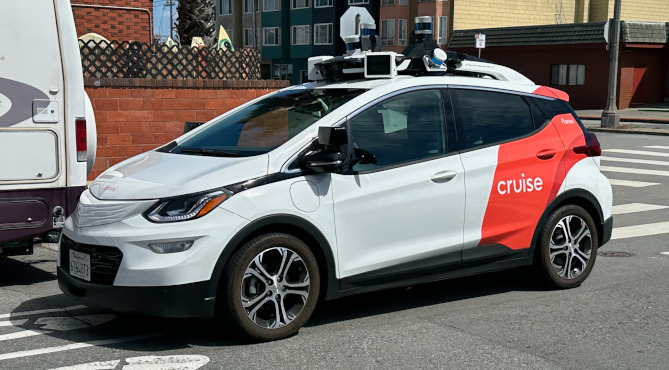
I’m in San Francisco this week hanging out with a relative and everywhere I go I see driverless Cruise and Waymo cars inching about the streets. Based on my years in transportation advocacy and my highly uniformed opinion, I have two prognostications about these things:
1. Autonomous cars will mostly, kinda work in some places but will require significant alterations to the built environment to function fully. They will bump up against that conceptual horizon at which it becomes impossible quantize the unquantizable. Human beings and the environments we create, combined with the complexity of the weather result in unknowable unknowns that no computer algorithm can anticipate. I can maybe see these things bumbling about the calmer parts of San Francisco but good luck in Los Angeles where there’s a culture of speeding and sociopathic driving, or snow, ice, fog and all the other variables of Mother Nature.
As Paris Marx points out in his book Road to Nowhere: What Silicon Valley Gets Wrong about the Future of Transportation, accommodating self driving vehicles will replay what happened in the early 20th century when the automobile and oil industries pushed for significant changes to our roads and cities to make cars work. For instance, these powerful economic and political industries turned the simple act of crossing the street into “jaywalking”. Then there’s all the parking lots, highways, gas stations and other infrastructure that worsened the quality of our built environment. As Marx points out, autonomous vehicle advocates have already speculated about gates for pedestrians at intersections as well as requiring all pedestrians and cyclists to wear beacons.
2. Politicians of both parities will be seduced by Silicon Valley’s hype and money instead of doing the boring and tedious work of building out and improving existing public transportation. This will prolong the failed embrace of the automobile and their effect on our cities and climate. Improvements that could happen right now, like better bus service and new rail lines, will be postponed indefinitely.
Resistance
But autonomous vehicles are not popular and the reaction to them reflects a growing uneasiness with Silicon Valley’s products. Activists in San Francisco have discovered that if you put a cone on the hood these things it will stop them, an echo of the early 20th century when mobs would swarm and beat up wealthy automobile owners. I’ve noticed that the Cruise cars have a phrase stenciled on their sensor apparatus warning, “Records audio and video,” as if the company knows they are hated. San Franciscans seem both horrified and delighted that one got stuck in wet concrete this week and a bunch bricked themselves due to “connectivity” issues relating to a large music festival. Despite these concerns, the California Public Utilities commission voted to let these companies start charging for rides.
I see some hope in my own Los Angeles neighborhood. The councilman I volunteered for during the election, Hugo Soto-Martinez, is about to begin a process of bus and bike improvements in his district. Unlike his corporate predecessor, Soto-Martinez plans on enlisting volunteers to engage in door-to door conversations with residents and business owners about these improvements, listening to people’s concerns and carefully explaining the benefits of the changes he wants to make. This is the hard work of politics, something our tech overlords try avoid and subvert.
The changes we need to make are a matter of hands-on politics, not waiting around for some grand technological fix. While technology can definitely contribute to improving mass transit, I think we’re going to need to lean more on rhetoric to shift us all away from the car-centric errors of the 20th century. I have some notions about the type of arguments to make but that will have to wait for another blog post. I’ll just say that I think autonomous cars are a distraction from this vital work.
Wait there’s more . . .
I can’t help but point out that one of the best documents of what cities looked like in America before “jaywalking” became a thing is this film of Market Street in San Francisco in 1906, shot just four days before the devastating earthquake and fire. To modern eyes this street scene seems chaotic but I would argue that we should see it as more democratic since no one type of transportation, horses, cars, trains, pedestrians or cyclists have priority. In our present time if you can afford to own a car you get priority over everyone else. Autonomous vehicles are just a continuation of this bias.
At the end of Market Street in this film you can see the Ferry Building which was obscured by a double decked highway built in 1959. When this ugly concrete mass collapsed in the 1989 earthquake it was, thankfully, demolished and not replaced. Hopefully similar wisdom will prevail and we’ll stop building infrastructure for private transportation.
Thanks for the treacherous update, Erik. This is a frightening development in my view, and my view is pedestrian level. Aren’t the smartest cities closing down to vehicles, keeping public transport, and opening up to bikes and pedestrians? In Chicago during the height of covid all kinds of streets were blocked and neighbors had potlucks, played music, and got to know each other. Actual life.
Are you back in Chicago?
Interesting article. Loved the film.
We’re in NZ camping but home is now in a small town in Michigan a couple hours outside Chicago.
Mannlicher Carcano improvised a soundtrack to this film a couple of years ago!